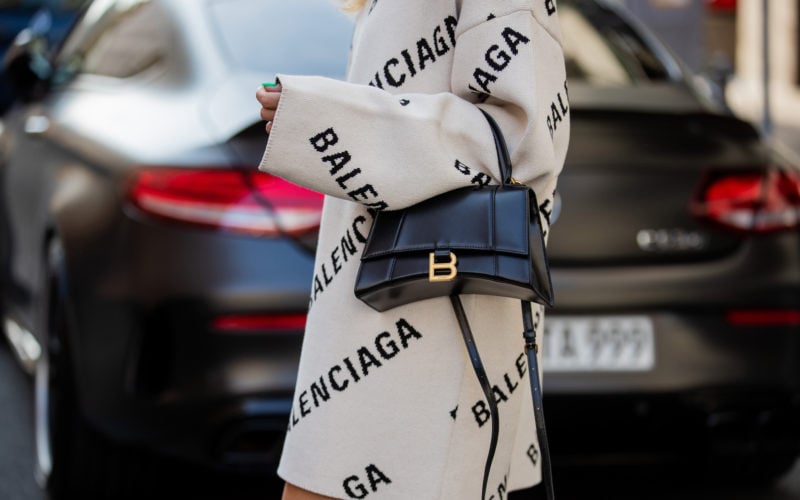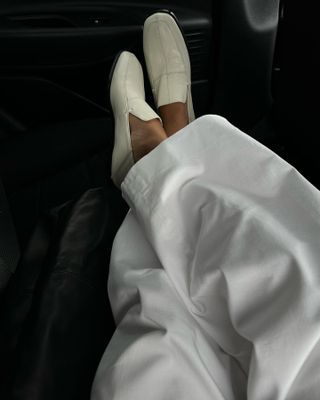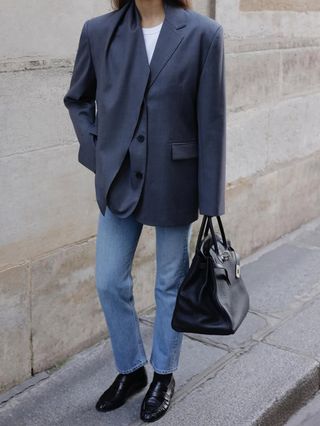
Photography by Getty Images
From burning shoes to ripping up sweaters, there’s a growing trend of destroying Balenciaga items amid the brand’s ad campaign scandal. But is that really the best solution?
Date December 21, 2022
It’s been over a month since Balenciaga was first accused of sexualizing children in two controversial ad campaigns. The first, as part of a holiday gifting series, showed children holding handbags that looked like teddy bears dressed in bondage gear. The second was a spring 2023 advertisement, released five days later, showing a handbag perched on a pile of paper, which reportedly included documents referencing a U.S. Supreme Court case about child pornography. Since these regrettable releases, the backlash against Balenciaga has only intensified.
For starters, celebrities that work with the brand have been called on to publicly cut ties. Bella Hadid reportedly deleted a number of promotional Instagram posts. Alexa Demie is rumoured to have ended her relationship with the fashion house. Most notably, Kim Kardashian, who has arguably been Balenciaga’s biggest supporter over the past year, shared a statement condemning the campaign and revealing that she’s “re-evaluating” her relationship with the luxury label.
On social media, the destruction of Balenciaga products has emerged as a trend of its own; a way of publicly taking a stand against the brand. At the time of publishing, #CancelBalenciaga has 255 million views on TikTok (and rising). Within that hashtag, viral videos show people burning their sneakers, slicing open their shoulder bags or attempting to rip up their clutches. But these theatrical displays of disdain raise their own set of sustainability and moral concerns. All of it leads us to ask: Is there a right way to “cancel” Balenciaga? Here’s what you should know.
It shouldn’t be the consumer’s job to answer for Balenciaga’s actions
Over the past few weeks, Balenciaga and creative director Demna have been accused of deflecting blame. After threatening legal action against “the parties responsible,” the brand reportedly initiated a $25 million lawsuit against the production company and set designer for the spring 2023 advertisement shoot. This prompted more industry backlash, and a week later, the lawsuit was dropped. Despite issuing multiple apologies, these actions have, in many ways, further alienated longtime supporters.
Toronto-based couple Anjli Patel and Parambir Keila, who have been Balenciaga customers for 15 years, are one such example. Most of their personal collection comprises items by Nicolas Ghesquière, the label’s creative director from 1997 to 2012. The two pieces they own that were designed by Demna — a pair of speed trainers and a 3D-printed jacket from the fall 2018 collection — they no longer plan to wear. “Pre-scandal, part of Demna’s legacy was designing and presenting (in our opinion) the single best modern-day couture collection: Balenciaga haute couture fall 2021,” they write in an email. “Now Demna’s designs and legacy are tainted by pushing pedophilia.” They say as long as Demna remains the creative director, they won’t be buying Balenciaga at all.
But on social media, the trend of burning, cutting up or trashing Balenciaga items sends the wrong idea, says Shelley Haines, a lecturer at Toronto Metropolitan University’s Fashion program and a Ph.D. candidate studying sustainable fashion. “It [puts pressure] on the consumer who has already spent money on these products — and they’re obviously really expensive — to then just dispose of them and to create a show of that,” she says. “Which I think is somewhat problematic.” The thing is, many people save up for months (or years) to buy a designer item. And once they do, it may hold a personal connection or happy memory that transcends the brand itself. Ultimately, Haines says you shouldn’t feel pressured to throw away things you already own because of this controversy. Not to mention, doing so is needlessly wasteful.
Destroying your Balenciaga clothes is *not* a sustainable solution
Burning or cutting a garment makes a strong statement of anti-Balenciaga solidarity, says Haines. But while it may garner millions of views, it doesn’t directly help those who were harmed in the controversy or solve anything long-term. “I think if we saw Kim Kardashian doing that, who’s made a lot of money from the company, it would be pretty significant,” she explains. “But somebody who has invested their own money to turn around and burn it? I don’t know that that message is translating to Balenciaga in the same way.”
In fact, ripping something to shreds and tossing it away only creates more textile waste, thereby contributing to a major issue in the fashion industry. “Our landfills are inundated with clothes already,” says Haines. “So it’s perpetuating that existing problem.” Plus, burning clothes made with synthetic fabrics like cotton-polyester blends or dyed leather only puts more strain on the environment. “It’s just releasing new chemicals into the air,” she says.
Donating your Balenciaga items isn’t always the answer either
Some say people should give their Balenciaga pieces to thrift stores, as it would make the brand more accessible and ultimately cause it to lose its luxury status. Haines agrees with this logic. “Sending it to the thrift store really devalues the brand. It would not be what the brand wanted,” she says, adding that many companies purposely destroy their products in an effort to avoid having them wind up in thrift stores.
“But then, it also puts a burden on somebody that maybe can’t afford it originally,” she continues. “It puts them in a situation where now they can obtain it, but they’re also perhaps supporting something that they don’t believe in, or they’re not even really familiar with.”
And while it’s less wasteful than sending something to a landfill, second-hand donations are not as sustainable as you might think. “Our thrift stores have way too much product and they barely keep any of it. They just send it to other countries and place the burden on them,” explains Haines. “What we donate is a small fraction of what we actually see in our local stores.” As for Patel and Keila, they say they plan to give their 3D-printed runway jacket to a museum. But what about items that aren’t collectibles?
Try upcycling the Balenciaga pieces you own
“It’s always best to keep what you already have, and to keep it going as long as you can,” says Haines. If you want to take a stand against Balenciaga, she suggests getting creative. For instance, by deconstructing and remaking something yourself — like turning a sweater into a pillow — you can build a positive association with it. “[People] could even protest with the garment by somehow destroying or manipulating the name,” she says, noting that you can add your own designs or cover up certain letters to distort the logo.
Alternatively, she suggests hiding the Balenciaga branding altogether. Case in point: some TikTok users have covered label-emblazoned sweaters with black duct tape or tucked-in logo-shaped handbag clasps to hide traces of the name. “You’re still wearing the item, but you’re no longer wearing it as a representation of the brand,” says Haines. “It’s now become your own, and it means something else.”
The bottom line? Be mindful of what you buy
Earlier this year, Balenciaga was named the most popular fashion brand in the world. Now, it’s possibly the most contentious. This can serve as a lesson to think more critically about the clothes we buy, explains Haines. “I think that we’ve seen enough examples now that the longevity of a brand is not always certain,” she says.
Logo-heavy items may tap into a trendy moment, but they don’t always stand the test of time. Before buying something designer, Haines suggests considering: “If things were to change for the brand, do I have something with a logo all over it? [Will I] be representing the brand every time I wear this?” If so, try opting for a more subtle garment that can still be worn if the company someday finds itself embroiled in controversy or does something you morally disagree with. Above all, buy something because you love it, not just because it’s popular. Take Patel and Keila, who have no plans to stop wearing their Ghesquière-era Balenciaga pieces. “If anything, we have a deeper reverence for these designs with each passing year,” they say.
The fact is: any brand can fall from grace. But Haines says we should reframe the way we think about dealing with it. Instead of hastily throwing things away, consider how to shop moving forward. “I don’t think you have to consume necessarily in fear of every brand being cancelled, but just thinking more generally [about] what that might look [like] as things change or evolve.”
























